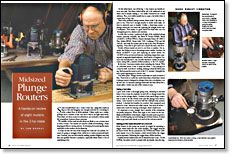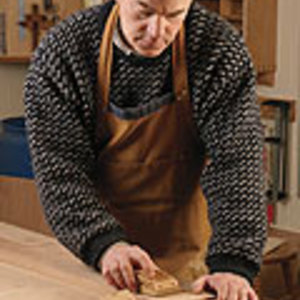All About Routers

Whole books have been written about routers and how to use them, and many woodworking shops have a collection of these tools designated for different kinds of work. Routers range in size from laminate trimmers that can be used with one hand to production tools with enough power for large-diameter profile bits and heavy work.
What Counts:
• Low vibration
• Power of motor and maximum bit capacity
• Ease and smoothness of operation for plunge routers
• Availability of speed control for large-diameter bits
• Quality of accessory fence
• Collet size
• Ease of bit changes
There are many variations on this tool but only two basic types: fixed base and plunge routers. Some routers are available as kits that include both a fixed base and a base for making plunge cuts. These offer a less costly alternative to buying two different tools.
Plunge routers
Plunge routers are the more versatile of the two. Bit depth can be changed while the machine is running simply by releasing a lock and moving the spring-loaded head up or down. They’re good for starting or stopping a cut away from an edge, as you would for a stopped dado or a mortise. The bit can be withdrawn from the work and stopped without moving the base from the work. A turret-style depth adjuster can be used to bring the bit down to three pre-set points.
Fixed-base routers
With a fixed-base router, bit height is typically adjusted (with the router turned off) by releasing a collar lock and turning the motor assembly to raise or lower it in the base. A scale on the base shows how much the bit has moved. These routers are available with a pair of handles, one on either side of the base, or a D-handle that includes the trigger.
Choose the right size
Small routers are designed for bits with 1/4-in. shanks, while full-size machines have different collets for 1/4-in., 1/2-in. and possibly 3/8-in. shanks. Given a choice, the bigger shank vibrates less and produces a cleaner cut. On heavy-duty routers used for large-diameter bits, it’s best to have a control for reducing bit speed as well as a soft-start feature that reduces the load on the machine when it starts up.
Aim for easy bit changing
Some routers require the use of two wrenches to loosen the collet and change the bit. More convenient are routers with a spindle lock and a single wrench. A dust port and a micro-adjust feature for bit height are two other desirable features.
Fine Woodworking Recommended Products

Bosch 12V Trim Router

Fein Turbo II HEPA Wet/Dry Dust Extractor

Festool DF 500 Q-Set Domino Joiner





















Log in or create an account to post a comment.
Sign up Log in